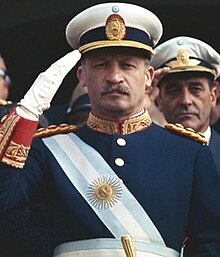Juan Carlos Onganía
This article needs additional citations for verification. (January 2013) |
Juan Carlos Onganía | |
|---|---|
 | |
| 35th President of Argentina De facto | |
| In office June 29, 1966 – June 8, 1970 | |
| Preceded by | Arturo Umberto Illia |
| Succeeded by | Roberto M. Levingston |
| Personal details | |
| Born | March 17, 1914 Marcos Paz, Buenos Aires |
| Died | June 8, 1995 (aged 81) Buenos Aires |
| Nationality | Argentine |
| Political party | none |
| Profession | Military |
| Military service | |
| Allegiance | Argentina |
| Branch/service | Argentine Army |
| Years of service | 1934–1970 |
| Rank | Lieutenant General |
Juan Carlos Onganía Carballo (Spanish pronunciation: [ˈxwaŋ ˈkarlos oŋɡaˈni.a]; March 17, 1914 – June 8, 1995) was de facto President of Argentina from 29 June 1966 to 8 June 1970. He rose to power as military dictator after toppling the president Arturo Illia in a coup d'état self-named Revolución Argentina (Argentine Revolution). (Although Peronism - the chief political force in Argentina at the time - was proscribed, Illia's UCR was generally seen as legitimately elected.)
Economic and social policies
While preceding military coups in Argentina were aimed at establishing temporary, transitional juntas, the Revolución Argentina headed by Onganía aimed at establishing a new political and social order, opposed both to liberal democracy and to communism, which gave to the Armed Forces of Argentina a leading role in the political and economic operation of the country. The political scientist Guillermo O'Donnell named this type of regime "authoritarian-bureaucratic state",[1] in reference both to the Revolución Argentina, the Brazilian military regime (1964–1985), Augusto Pinochet's regime (starting in 1973) and Juan María Bordaberry's regime in Uruguay.
While Chief of the Army in 1963, Onganía helped crush the 1963 Argentine Navy Revolt by mobilizing troops that seized rebelling Navy bases. However, he demonstrated a disregard for civil authority when he initially refused to call off his troops after a ceasefire agreement had been approved by President José María Guido and his cabinet, and was only convinced to follow orders after a tense meeting.[2]
As military dictator, Onganía suspended political parties and supported a policy of Participacionismo (Participationism, supported by the trade unionist José Alonso and then by the general secretary of the CGT-Azopardo, Augusto Vandor), by which representatives of various interest groups such as industry, labor, and agriculture, would form committees to advise the government. However these committees were largely appointed by the dictator himself. Onganía also suspended the right to strike (Law 16,936) and supported a corporatist economic and social policy, enforced particularly in Cordoba by the appointed governor, Carlos Caballero.
Onganía's Minister of Economy, Adálbert Krieger Vasena, decreed a wage freeze (amid 30% inflation) and a 40% devaluation, which adversely impacted the state of the Argentine economy (agriculture in particular), favoring foreign capital. Krieger Vasena suspended collective labour conventions, reformed the Fossil Fuels Law which had established a partial monopoly of the Yacimientos Petrolíferos Fiscales (YPF) state enterprise and also signed a law facilitating the expulsion of tenants in cases of non-payment of rent.
Cultural and education policy

Onganía's rule signified an end to university autonomy, which had been achieved by the University Reform of 1918.[3]
Barely a month into his administration, he was responsible for the violation of university autonomy in the so-called La Noche de los Bastones Largos ("The Night of the Long Police Batons") in which he ordered police to invade the Faculty of Sciences of the University of Buenos Aires. Students and professors were beaten up and arrested. Many were later forced to leave the country, beginning a "brain drain" that adversely affects Argentine academia to this day.[4]
Onganía also ordered repression on all forms of "immoralism", proscribing miniskirts, long hair for boys, and all avant-garde artistic movements.[3] This moral campaign favorized the radicalization of the middle classes, who were very over-represented in universities.[3] In 1969, Ongania dedicated the country to the Immaculate Heart of Mary.[5]
Protests
Eventually, this position was opposed by the other factions in the military, which felt that its influence in government would be diminished. At the end of May 1968, General Julio Alsogaray dissented from Onganía, and rumors spread about a possible coup d'état, Algosaray leading the conservative opposition to Onganía. Finally, at the end of the month, Onganía dismissed the leaders of the Armed Forces: Alejandro Lanusse replaced Julio Alsogaray, Pedro Gnavi replaced Benigno Varela, and Jorge Martínez Zuviría replaced Adolfo Alvarez.
Also, Ongania's ruthless government was weakened by a popular uprising of workers and students that took place in the whole of the country, in particular in the interior, in cities such as Córdoba in 1969 (known as "El Cordobazo") or Rosario (the Rosariazo). In May 1970, a second Cordobazo happened, nicknamed el Viborazo.[3]
The dominant military faction, led by General Lanusse, demanded that Onganía resign. When he refused, he was toppled by a military junta.
See also
- Jorge Rafael Videla Argentine military officer who would later succeed Ongania.
References
- ^ Guillermo O'Donnell, El Estado Burocrático Autoritario, (1982)
- ^ Potash, Robert A. (1996). The Army and Politics in Argentina 1962-1973. Stanford, California: Stanford University Press. pp. 99–100. ISBN 9780804724142.
- ^ a b c d Carmen Bernand, « D’une rive à l’autre », Nuevo Mundo Mundos Nuevos, Materiales de seminarios, 2008 (Latin-Americanist Review published by the EHESS), Put on line on 15 June 2008. URL : http://nuevomundo.revues.org//index35983.html Accessed on 28 July 2008. Template:Fr icon
- ^ http://www.clarin.com/diario/2005/04/28/sociedad/s-03601.htm Clarín
- ^ http://books.google.com/books?id=4Vi0SEdZRN0C&pg=PA67&lpg=PA67&dq=juan+carlos+ongania+immaculate&source=bl&ots=4OMaHIuTzI&sig=gzRa2QzJJ2WR6b4gra4TbN0cLak&hl=en&ei=-goiTYX_L8P38AbvzNzWDQ&sa=X&oi=book_result&ct=result&resnum=6&ved=0CDkQ6AEwBQ#v=onepage&q=juan%20carlos%20ongania%20immaculate&f=false

